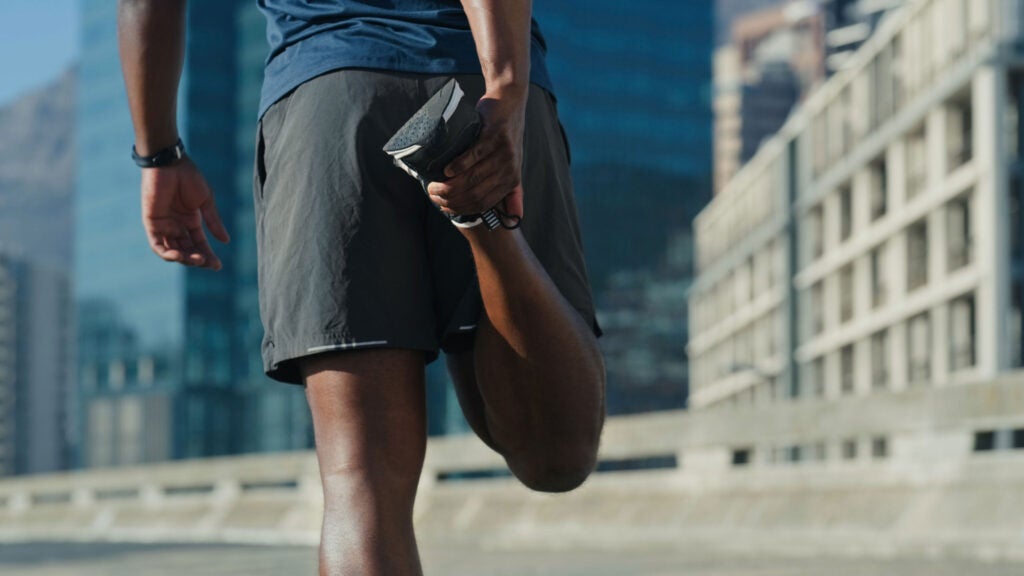No products in the cart.
Outdoor Adventure
The Full-Body Stretch Routine You Should Be Doing
Heading out the door? Read this article on the new Outside+ app available now on iOS devices for members!
Download the app.
Whether you identify as a runner, cyclist, or hiker, you likely know that you should be incorporating a full-body stretch routine into your day. However, it can be difficult to know which exercises to do. (And, when you don’t know, it offers an easy excuse to skip.)
Here, we break down eight movements you can turn to on a regular basis to keep your body ready for all of your outdoor adventures.
Do I Need to Do a Full-Body Stretch?
We get it: You’d rather be out on the mountain or hitting the trail than forward folding in the parking lot. However, there are a number of benefits of stretching for outdoor athletes.
The Benefits of a Full-Body Stretch Routine for Outdoor Athletes
- It increases your range of motion and flexibility. A 2016 study published in Physiotherapy: Theory and Practice found that static stretching can improve your range of motion and increase your flexibility. Another study cited the same result for dynamic stretching done prior to a workout. This can help you optimize your movement mechanics—and help you avoid feeling stiff and sore after outdoor exercise.
- It delays potential soreness. Incorporating stretching into a cooldown can help minimize the severity of delayed-onset muscle soreness (DOMS), according to recent research.
- It can decrease your risk of injury. A 2021 study published in Sports Health found that dynamic stretching helps activate your muscles prior to a workout, improving your movement efficiency and reducing your risk of injury.
The Best Full-Body Stretch Routine for Outdoor Athletes
Looking for some inspiration? Try completing this full-body stretch routine after your workout a few days a week.
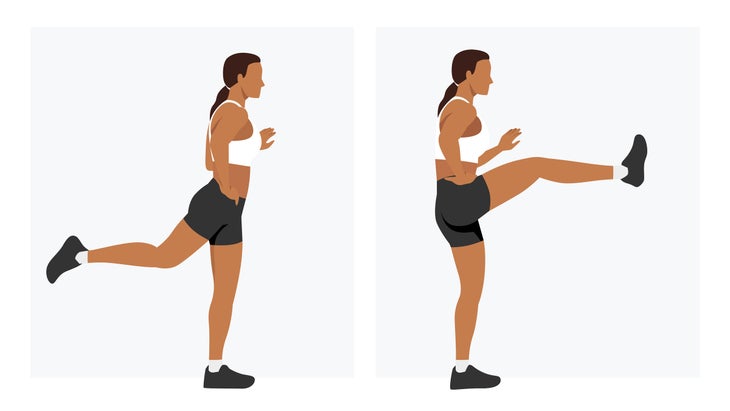
1. Leg Swings
This pre-workout stretch will help open up your hips, loosen your hip flexors and glutes, and increase blood flow to your legs.
How to do it:
- Come to stand. Position your body perpendicular to a wall, chair, or pole and hold onto it with your right hand.
- Lift your left leg and swing it back and forth in front of and behind your body (like a pendulum). Keep your left knee straight. Maintain a soft bend in your right leg to avoid locking it out.
- Keep your core and glutes engaged. Your torso should remain stationary and upright. Avoid hunching over.
- Complete 15 leg swings. As you warm up, you can increase your range of motion with each swing.
- Switch legs and repeat.

2. Downward Dog
Downward dog is a yoga pose that stretches the entire posterior chain of your body, which includes your hamstrings, glutes, calves, Achilles tendons, lower back, upper back, and shoulders. This move is particularly beneficial for cyclists who ride in an aerodynamic position, as well as runners and hikers who tend to feel tightness in their lower body.
How to do it:
- Come into a tabletop position. Place your hands slightly in front of your shoulders. Your knees should be directly underneath your hips. Curl your toes under your feet.
- Spread your fingers. Press your palms firmly into the floor.
- Lift your knees off of the floor. As you straighten your legs, press your heels down and raise your butt into the air. Your body should be folded at the hips into an inverted “V” shape. Make sure your chest faces your thighs.
- Draw your belly button toward your spine to engage your core. Keep your gaze toward your feet to maintain a neutral position in your neck and spine.
- To give a deeper stretch to your Achilles, bend your knees slightly while pressing your heels down.
- Hold this position for 30 seconds.
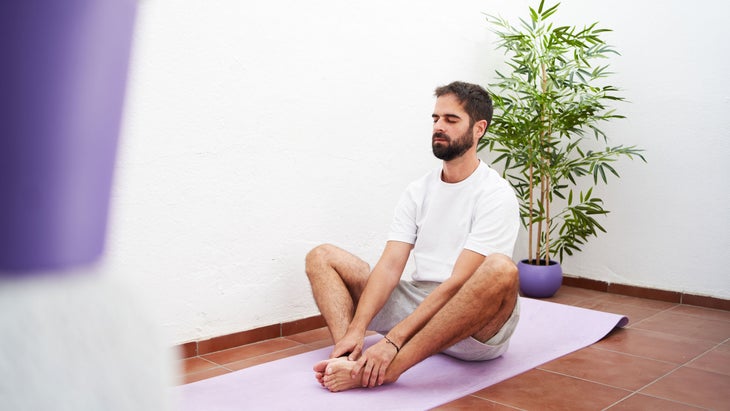
3. Butterfly Stretch
This move stretches your groin, glutes, and the adductor muscles along your inner thighs, while also opening up your hips.
How to do it:
- Sit upright on the floor with your knees bent and your feet flat.
- Place the soles of your feet together in front of your body. Allow your knees to fall out to the sides. Your legs should be a diamond shape.
- Keep your core engaged and your back straight. To deepen the stretch, use your elbows to gently press down on the inside of your knees. Hinge forward from your hips.
- Hold this position for 30 seconds.
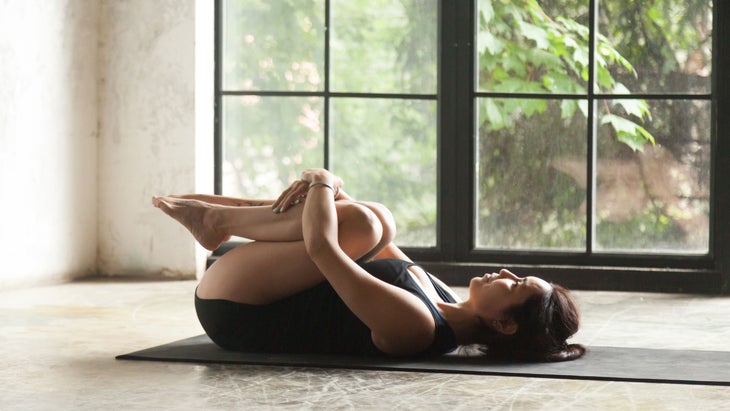
4. Knees-to-Chest Stretch
If you’re a cyclist, runner, or just spend the majority of your day hunched over a screen (guilty!), this stretch will provide some relief to your lower back.
How to do it:
- Lie on your back.
- Bend your knees. Bring them toward your chest.
- Use your arms to hug your knees in place. To get a deeper stretch, squeeze tighter.
- Hold for 30 seconds.
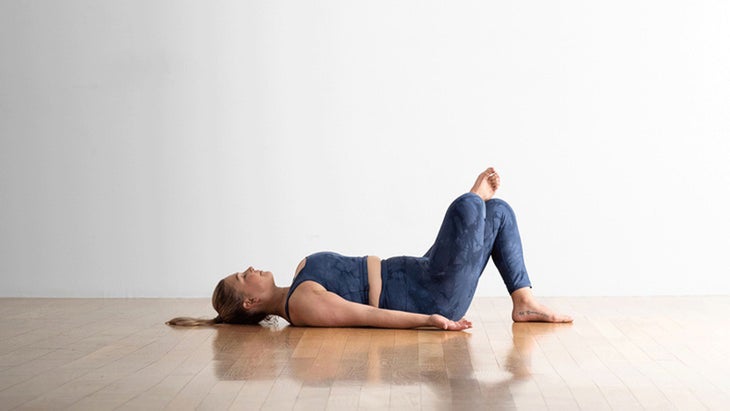
5. Glutes/Piriformis Stretch
This is one of my go-to stretches for outdoor athletes because it stretches your glutes and deep piriformis muscle, which have a tendency to get tight with repetitive motions.
How to do it:
- Lie on your back with your knees bent and your feet flat on the floor.
- Lift your left foot off the floor. Create a 90-degree angle with your leg. Your shin should be parallel to the floor. Hold the leg in this position.
- Bend your right leg. Rest your right ankle on your left thigh. Rotate your right hip outward.
- While holding this position, grab behind your left thigh with one or both hands. Pull the leg in toward your chest. For a deeper stretch, press your right thigh away from your body with your right hand while hugging your left leg in.
- Hold for 30 seconds before switching sides.
6. IT Band Stretch
If you’re an outdoor athlete, you likely have tight IT bands. This post-workout stretch not only helps massage this connective tissue but also stretches your hamstrings, lower back muscles, calves, and glutes.
How to do it:
- Stand upright. Cross your right leg over your left leg. Your right heel and ankle should be planted to the outside of your left foot.
- Keep your knees straight. Hinge at your hips and reach toward your toes.
- Hold for 20 to 30 seconds. Stand up and switch legs.

7. Standing Quad Stretch
This static stretch targets your quads and hip flexors, while also improving your balance.
How to do it:
- Stand upright with good posture.
- Lift your right foot off the ground. Bend your knee. Pull your heel behind you (toward your butt) with your right hand.
- Try to keep your knees aligned. Don’t allow your left knee to drift out to the side.
- Hold for 20 seconds.
- Press your pelvis forward. Lean back slightly with your torso. You should feel a stretch in your hip flexor.
- Hold for 20 seconds before switching sides.
8. Chest Stretch
The muscles in your upper body are likely in need of a stretch, especially if you’re a skier, swimmer, or hiker. This move offers relief to the pectoral muscles in your chest and the anterior deltoids in the front of your shoulders.
How to do it:
- Face an open doorway. Lift your arms up and out to the sides. Your body should form a T shape.
- Step one foot forward through the doorway. Your straightened arms should catch on the sides of the door frame.
- Keep your gaze forward and your spine upright.
- Hold for 30 seconds. Switch your front leg and repeat.
Source link

